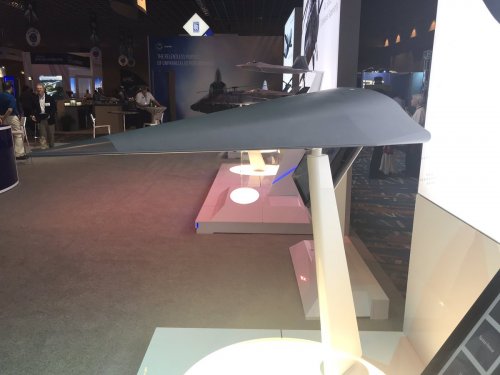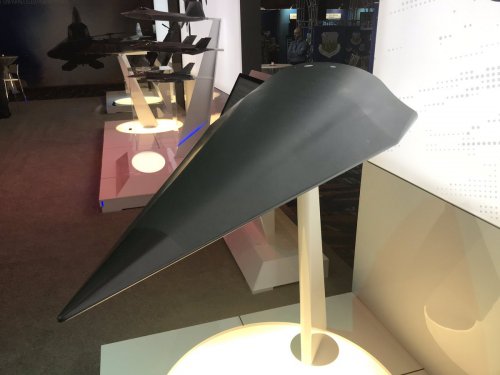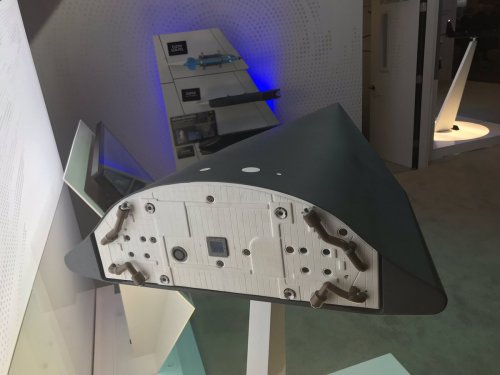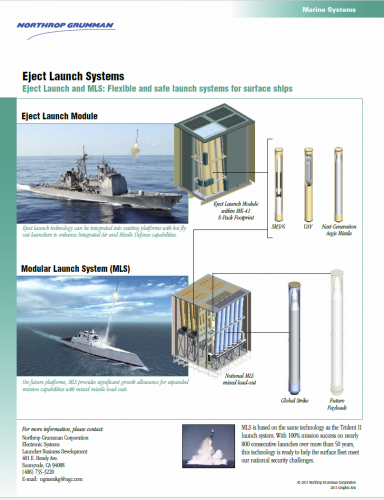You are using an out of date browser. It may not display this or other websites correctly.
You should upgrade or use an alternative browser.
You should upgrade or use an alternative browser.
US Hypersonics - Prompt Global Strike Capability
- Thread starter bobbymike
- Start date
-
- Tags
- united states
- Joined
- 31 December 2006
- Messages
- 802
- Reaction score
- 363
http://www.airforcemag.com/Features/Pages/2018/August%202018/Lockheed-Gets-Yet-Another-Hypersonic-Missile-Contract.aspx
In addition to the ARRW, HCSW, TBG, and HAWC, Lockheed's "Skunk Works" is believed to still be working on the High Speed Strike Weapon, which sources say is a tactical missile in the Mach 3-plus category that resembles its D-21 drone, which USAF launched from SR-71s and B-52s in the 1970s. The HSSW is derivative of the Revolutionary Approach to Time Critical Long Range Strike program Lockheed explored with the Navy in the early 2000s.
- Joined
- 3 June 2011
- Messages
- 18,333
- Reaction score
- 12,220
George Allegrezza said:http://www.airforcemag.com/Features/Pages/2018/August%202018/Lockheed-Gets-Yet-Another-Hypersonic-Missile-Contract.aspx
In addition to the ARRW, HCSW, TBG, and HAWC, Lockheed's "Skunk Works" is believed to still be working on the High Speed Strike Weapon, which sources say is a tactical missile in the Mach 3-plus category that resembles its D-21 drone, which USAF launched from SR-71s and B-52s in the 1970s. The HSSW is derivative of the Revolutionary Approach to Time Critical Long Range Strike program Lockheed explored with the Navy in the early 2000s.
That would almost be too good to be true. Still never understood why they gave up RATTLRS.
seruriermarshal
ACCESS: Top Secret
- Joined
- 4 May 2008
- Messages
- 1,180
- Reaction score
- 574
sferrin said:George Allegrezza said:http://www.airforcemag.com/Features/Pages/2018/August%202018/Lockheed-Gets-Yet-Another-Hypersonic-Missile-Contract.aspx
In addition to the ARRW, HCSW, TBG, and HAWC, Lockheed's "Skunk Works" is believed to still be working on the High Speed Strike Weapon, which sources say is a tactical missile in the Mach 3-plus category that resembles its D-21 drone, which USAF launched from SR-71s and B-52s in the 1970s. The HSSW is derivative of the Revolutionary Approach to Time Critical Long Range Strike program Lockheed explored with the Navy in the early 2000s.
That would almost be too good to be true. Still never understood why they gave up RATTLRS.
Perhaps RATTLRS into HSSW in black project .
- Joined
- 9 October 2009
- Messages
- 21,947
- Reaction score
- 13,583
bobbymike said:http://aviationweek.com/future-aerospace/generation-orbit-fires-hypersonic-testbed?NL=AW-05&Issue=AW-05_20180703_AW-05_204&sfvc4enews=42&cl=article_2&utm_rid=CPEN1000000230026&utm_campaign=15475&utm_medium=email&elq2=0ef065e588ed4e2d812c58710cdf5367
Generation Orbit Launch Services has completed the first hot-fire test of a full-scale prototype of its GOLauncher1 (GO1) hypersonic flight-test booster.
The startup is developing the air-launched GO1 for the U.S. Air Force Research Laboratory (AFRL) as an affordable and flexible hypersonic testbed.
The firing was the first of its kind to be conducted at Cecil Spaceport in Jacksonville, Florida, and also GO’s first test campaign with Ursa Major Technologies’ Hadley liquid rocket engine. The 5,000 lb. thrust-class oxygen-rich staged combustion engine performed as expected through the tests, GO said.
I posted my thoughts a couple years back just get a Roadrunner II SRM put a BGV on the front end ya got a near term hypersonic strike weapon.
https://www.flightglobal.com/news/articles/usaf-designates-golauncher1-hypersonic-research-rock-452476/
The US Air Force has applied the official military designation of X-60A to a hypersonic research rocket formerly known as GOLauncher1.
The vehicle is being developed by Generation Orbit Launch Services under contract to the Air Force Research Laboratory’s (AFRL) Aerospace Systems Directorate, High Speed Systems Division, the service said 4 October.
The X-60A is an air-dropped liquid rocket designed for hypersonic flight research, including testing of technologies like scramjet propulsion, high-temperature-resistant materials and autonomous control.
- Joined
- 21 April 2009
- Messages
- 13,747
- Reaction score
- 7,670
http://aviationweek.com/defense/sandia-s-swerve-could-lead-first-gen-hypersonic-production-line
The veil of secrecy has lifted over one of the Pentagon’s largest hypersonic weapons programs, revealing new details of a triservice rush to adapt a nearly 40-year-old experimental maneuvering reentry vehicle concept into an air-, sea- or land-launched common-boost-glide weapon.
The revelations provide deeper insight into plans that unite three separate projects—the U.S. Army’s Advanced Hypersonic Weapon (AHW), the Air Force’s Hypersonic Conventional Strike Weapon (HCSW) and the Navy’s Conventional Prompt Strike (CPS)—under a single Defense Department-wide program to field a Mach 6 missile by 2021.
- Joined
- 21 April 2009
- Messages
- 13,747
- Reaction score
- 7,670
ATK just a successful test of the GEM-63 SRM would be a perfect strike missile combo IMHO.sferrin said:Hopefully it won't be a, "whoa, this is harder than we thought. Those guys were really smart. We better cancel it." moment like LRASM-B.
- Joined
- 3 June 2011
- Messages
- 18,333
- Reaction score
- 12,220
bobbymike said:ATK just a successful test of the GEM-63 SRM would be a perfect strike missile combo IMHO.sferrin said:Hopefully it won't be a, "whoa, this is harder than we thought. Those guys were really smart. We better cancel it." moment like LRASM-B.
They're north of 100,000lbs and 65+ feet long, and you'd need a 2nd stage, so. . .
DrRansom
I really should change my personal text
- Joined
- 15 December 2012
- Messages
- 701
- Reaction score
- 301
sferrin said:Hopefully it won't be a, "whoa, this is harder than we thought. Those guys were really smart. We better cancel it." moment like LRASM-B.
It could be worse, the SWERVE could give an out to solving the hard problems of hypersonics. So the US gets something NOW - but China solves the problem of TPS, controls, etc. and outmatches the US in the mid-term.
- Joined
- 3 June 2011
- Messages
- 18,333
- Reaction score
- 12,220
Report to Congress on Conventional Prompt Global Strike and Long-Range Ballistic Missiles
"The Pentagon’s budget request for FY2019 increases funding for the CPGS program from around $201 million in FY2018 to $278 million in FY2019; it also shows significant increases in funding over the next five years, with a total of $1.9 billion allocated to the program. This shows the growing priority placed on the program in the Pentagon and the growing interest in Congress in moving the program forward toward deployment."
https://news.usni.org/2019/01/10/report-congress-conventional-prompt-global-strike-long-range-ballistic-missiles
"The Pentagon’s budget request for FY2019 increases funding for the CPGS program from around $201 million in FY2018 to $278 million in FY2019; it also shows significant increases in funding over the next five years, with a total of $1.9 billion allocated to the program. This shows the growing priority placed on the program in the Pentagon and the growing interest in Congress in moving the program forward toward deployment."
https://news.usni.org/2019/01/10/report-congress-conventional-prompt-global-strike-long-range-ballistic-missiles
bring_it_on
I really should change my personal text
- Joined
- 4 July 2013
- Messages
- 3,661
- Reaction score
- 3,802
Thanks Sfferin! FE-2 currently planned by end of FY20..
The DOD budget request for FY2019 indicates that it will conduct a second flight test by the end of FY2020. The budget request also contains no funds for the OSD-wide account for Prompt Global Strike Capability Development after FY2019 and indicates that “Conventional Prompt Strike program and funding transfers to the Navy” starting in FY2020. Moreover, funding for the program is expected to increase significantly, from a request for $278 million in FY2019 to a request for $478 million in FY2022, for a total of $1.9 billion between FY2019 and FY2022. This is more than twice the amount expected over a five-year period in the FY2018 budget request.
FY18
In June 2018, the Pentagon submitted a reprogramming request to Congress that added $159.5 million to the FY2018 budget for Prompt Global Strike Capability Development. According to the documents supporting the reprogramming request, $40.0 million would increase production of the hypersonic glide vehicles and prototypes, possibly to five per year, to support the Navy’s CPS program; $34.5 million would address the lack of autoclaves (high-temperature and pressure ovens) needed to produce the thermal protection systems for the CPS hypersonic glide vehicles; and $20.0 million would improve the test and evaluation (T&E) infrastructure needed to support full-scale testing of the CPS system. The request also included $65 million to support an accelerated demonstration of a new land-launched hypersonics capability. With this reprogramming request in place, funding for Prompt Global Strike Capability Development in FY2018 totaled $374.9 million.1
FY19
The budget documents indicate that, in FY2019, the program will focus on manufacturing and testing the booster and hypersonic glide body that will be used in the second Flight Experiment test and begin manufacturing and testing of the hypersonic glide body that will be used in the third test. It will also, among other tasks, “continue studies for future system development to examine cost, lethality, aerodynamic and thermal characteristics” and “conduct trade studies to evaluate system alternatives, affordability, and end-to-end system concepts.” Congress, in the National Defense Authorization Act for FY2019 (P.L. 115-232), increased funding for Prompt Global Strike Capability Development to $413.4 million, adding $150 million to accelerate the program. This total represents an increase of 57% over the Administration’s request for FY2019, and an increase of 40% over the amount approved for FY2018 when the July 2018 reprogramming request is included in the total. Congress also increased funding for the program in the Department of Defense Appropriations Act, 2019 (P.L. 115-245), by $186 million, to a total of $466.9 million.
- Joined
- 17 October 2006
- Messages
- 2,393
- Reaction score
- 1,197
For pdf fans...
https://fas.org/sgp/crs/nuke/R41464.pdf
https://fas.org/sgp/crs/nuke/R41464.pdf
aonestudio
I really should change my personal text
- Joined
- 11 March 2018
- Messages
- 2,964
- Reaction score
- 7,486
30 January 2019
The US Naval Air Systems Command (NAVAIR) issued a sources sought notification on 22 January to solicit potential tenders for the upgrade of the Launch Test Complex (LTC) at Naval Air Weapons Station (NAWS) China Lake, California, to support the Conventional Prompt Strike (CPS) weapon programme.
https://www.janes.com/article/86047/us-navy-to-develop-china-lake-to-support-cps-weapon-testing
The US Naval Air Systems Command (NAVAIR) issued a sources sought notification on 22 January to solicit potential tenders for the upgrade of the Launch Test Complex (LTC) at Naval Air Weapons Station (NAWS) China Lake, California, to support the Conventional Prompt Strike (CPS) weapon programme.
https://www.janes.com/article/86047/us-navy-to-develop-china-lake-to-support-cps-weapon-testing
bring_it_on
I really should change my personal text
- Joined
- 4 July 2013
- Messages
- 3,661
- Reaction score
- 3,802
2/26/19
Lockheed Martin Space, Littleton, Colorado, is awarded a maximum amount $846,030,000 un-priced letter contract modification PH0001 to a previously awarded and announced un-priced letter contract (N00030-19-C-0025) for the design, development, build and integration of large diameter rocket motors, associated missile body flight articles, and related support equipment for Navy Intermediate Range Conventional Prompt Strike Weapon System flight test demonstrations. Work will be performed at Littleton, Colorado, with an expected completion date of Jan. 1, 2024. Fiscal 2018 research, development, test, and evaluation funds in the amount of $20,000,000 are obligated on this award, which will expire at the end of the current fiscal year. Fiscal 2019 research, development, test, and evaluation funds in the amount of $67,000,000 are being obligated on this award, which will not expire at the end of the current fiscal year. Strategic Systems Programs, Washington, District of Columbia, is the contracting activity.
seruriermarshal
ACCESS: Top Secret
- Joined
- 4 May 2008
- Messages
- 1,180
- Reaction score
- 574
- Joined
- 21 January 2015
- Messages
- 12,141
- Reaction score
- 16,331
Defense contractor Raytheon just signed a $63.3 million contract with the Defense Advanced Research Projects Agency (DARPA) to develop a “tactical boost glide” (TBG) hypersonic weapons program.
The weapon system could reach hypersonic speeds of up to five times the sound barrier thanks to a rocket engine. A payload will then glide the rest of the way to the intended target — completely unpowered, without the ability to accelerate again. But operators will be able to maneuver it from a distance.
https://futurism.com/the-byte/raytheon-hypersonic-tactical-boost-glide
bring_it_on
I really should change my personal text
- Joined
- 4 July 2013
- Messages
- 3,661
- Reaction score
- 3,802
Those appear to be HTV2 pictures from the AFA"s AWS19 floor..
Source - https://twitter.com/TheDEWLine/status/1100892943995539456
Source - https://twitter.com/TheDEWLine/status/1100892943995539456
- Joined
- 21 January 2015
- Messages
- 12,141
- Reaction score
- 16,331
The
@AFResearchLab
, which is having a busy week, released a new video showing the X-60A concept for a liquid fuel rocket testbed for hypersonic flight conditions. The X-60A also just passed a critical design review.
https://twitter.com/TheDEWLine/status/1103454266428178433
https://youtu.be/Ud-dE1OnbFg
- Joined
- 3 June 2011
- Messages
- 18,333
- Reaction score
- 12,220
"In enemy hands, the new class of hypersonic speed maneuvering missiles may pose the greatest threat to the U.S. Navy’s heavily defended battle groups. At the same time, designing a hypersonic glide vehicle compatible with a submarine’s underwater launching system presents the hardest engineering task in a technology area that has eluded American mastery for decades.
It is perhaps no surprise, then, that the $10.5 billion war chest wedged into the Defense Department’s latest five-year spending proposal is dominated by the Navy’s Conventional Prompt Strike (CPS) program. Fulfilling its two assigned tasks—developing a common hypersonic glide vehicle that can be adapted for ground- and air-launch, plus demonstrating a sea-launched version with an integrated booster and glider—consumes about 55% of all U.S. military spending on offensive and defensive hypersonic weapons technology over the next five years, budget documents show. "
https://aviationweek.com/defense/us-accelerates-hypersonic-weapons-push-new-spending-plan
It is perhaps no surprise, then, that the $10.5 billion war chest wedged into the Defense Department’s latest five-year spending proposal is dominated by the Navy’s Conventional Prompt Strike (CPS) program. Fulfilling its two assigned tasks—developing a common hypersonic glide vehicle that can be adapted for ground- and air-launch, plus demonstrating a sea-launched version with an integrated booster and glider—consumes about 55% of all U.S. military spending on offensive and defensive hypersonic weapons technology over the next five years, budget documents show. "
https://aviationweek.com/defense/us-accelerates-hypersonic-weapons-push-new-spending-plan
- Joined
- 11 February 2010
- Messages
- 1,649
- Reaction score
- 2,698
sferrin said:"In enemy hands, the new class of hypersonic speed maneuvering missiles may pose the greatest threat to the U.S. Navy’s heavily defended battle groups. At the same time, designing a hypersonic glide vehicle compatible with a submarine’s underwater launching system presents the hardest engineering task in a technology area that has eluded American mastery for decades.
It is perhaps no surprise, then, that the $10.5 billion war chest wedged into the Defense Department’s latest five-year spending proposal is dominated by the Navy’s Conventional Prompt Strike (CPS) program. Fulfilling its two assigned tasks—developing a common hypersonic glide vehicle that can be adapted for ground- and air-launch, plus demonstrating a sea-launched version with an integrated booster and glider—consumes about 55% of all U.S. military spending on offensive and defensive hypersonic weapons technology over the next five years, budget documents show. "
https://aviationweek.com/defense/us-accelerates-hypersonic-weapons-push-new-spending-plan
Sounds like the navy wants Tomahawk sized, which can be made compatible with existing attack boats and basically shares infrastructures with other services. Basically US version of Zircon but with tighter constraint.
- Joined
- 6 August 2007
- Messages
- 3,892
- Reaction score
- 5,955
stealthflanker said:At the same time, designing a hypersonic glide vehicle compatible with a submarine’s underwater launching system presents the hardest engineering task in a technology area that has eluded American mastery for decades.
This is false. The Navy and Lockheed have been flying them on Trident test flights for years. These tail kits were very near production before Congress decided to stop funding them.
Even fitting a SWERVE-derived vehicle like AHW to a smaller booster compatible with the Virginia Payload Module is not some "hardest engineering task". It has been done and flight tested.
bring_it_on
I really should change my personal text
- Joined
- 4 July 2013
- Messages
- 3,661
- Reaction score
- 3,802
stealthflanker said:Sounds like the navy wants Tomahawk sized, which can be made compatible with existing attack boats and basically shares infrastructures with other services. Basically US version of Zircon but with tighter constraint.
Doesn't sound like that to me at all.
- Joined
- 3 June 2011
- Messages
- 18,333
- Reaction score
- 12,220
bring_it_on said:stealthflanker said:Sounds like the navy wants Tomahawk sized, which can be made compatible with existing attack boats and basically shares infrastructures with other services. Basically US version of Zircon but with tighter constraint.
Doesn't sound like that to me at all.
Me either. Bet it ends up KEI-sized and stuffed in a module on Virginias.
bring_it_on
I really should change my personal text
- Joined
- 4 July 2013
- Messages
- 3,661
- Reaction score
- 3,802
sferrin said:bring_it_on said:stealthflanker said:Sounds like the navy wants Tomahawk sized, which can be made compatible with existing attack boats and basically shares infrastructures with other services. Basically US version of Zircon but with tighter constraint.
Doesn't sound like that to me at all.
Me either. Bet it ends up KEI-sized and stuffed in a module on Virginias.
Well, the Navy wants a submarine launched Intermediate Ranged Prompt strike capability which means focusing on the existing AHW with a Navy specific booster. Given that FT-1 flew more than 3700 km..I just do not see how you can do this on something that is the size of the Tomahawk or with the performance of the Zircon which to the best of my knowledge is targeting shorter ranges and potentially a completely different propulsion concept (AB..scramjet?)
DARPA's TBG is also looking at VLS integration as part of its FY19 activities so that is probably something that may end up on the surface fleet...
Attachments
- Joined
- 3 June 2011
- Messages
- 18,333
- Reaction score
- 12,220
- Joined
- 11 February 2010
- Messages
- 1,649
- Reaction score
- 2,698
Well the key is "commonality". If air launch is envisaged then it would likely be "light enough" to carry en-masse, prob also in internal bay. So Tomahawk sized made sense for me. The glider and warhead will of course be small but GPS and kinetic will compensate that. Plus it needs to fit into existing Navy VLS's in numerous AB's.
But yeah, if it needs to be any larger, then new launcher will be needed and the air launched version might be limited in numbers of being carried to like 2-4 (assume B-52 carrier)
But yeah, if it needs to be any larger, then new launcher will be needed and the air launched version might be limited in numbers of being carried to like 2-4 (assume B-52 carrier)
bring_it_on
I really should change my personal text
- Joined
- 4 July 2013
- Messages
- 3,661
- Reaction score
- 3,802
stealthflanker said:Well the key is "commonality". If air launch is envisaged then it would likely be "light enough" to carry en-masse, prob also in internal bay. So Tomahawk sized made sense for me. The glider and warhead will of course be small but GPS and kinetic will compensate that. Plus it needs to fit into existing Navy VLS's in numerous AB's.
But yeah, if it needs to be any larger, then new launcher will be needed and the air launched version might be limited in numbers of being carried to like 2-4 (assume B-52 carrier)
There are physical limitations that are imposed by those performance requirements for speed and range. If you can build an Intermediate ranged, 4000km ish hypersonic BGV that is Tomahawk size and weight then you have a very lucrative career ahead of you
- Joined
- 11 February 2010
- Messages
- 1,649
- Reaction score
- 2,698
bring_it_on said:There are physical limitations that are imposed by those performance requirements for speed and range. If you can build an Intermediate ranged, 4000km ish hypersonic BGV that is Tomahawk size and weight then you have a very lucrative career ahead of you
I'm thinking of more moderate range TBH. not 4000's but rather shorter 1500-2000 km.
bring_it_on
I really should change my personal text
- Joined
- 4 July 2013
- Messages
- 3,661
- Reaction score
- 3,802
stealthflanker said:bring_it_on said:There are physical limitations that are imposed by those performance requirements for speed and range. If you can build an Intermediate ranged, 4000km ish hypersonic BGV that is Tomahawk size and weight then you have a very lucrative career ahead of you
I'm thinking of more moderate range TBH. not 4000's but rather shorter 1500-2000 km.
The US Navy's choice of a large diameter (>30 inches ) intermediate-range motor/booster is inconsistent with what you describe.
The Navy CPS WS will consist of the following primary subsystems:
•· Large-diameter (>30 inches) All Up Round (AUR) [encapsulated missile with a Hypersonic Glide Body (HGB)].
•· Weapon Control System (WCS) for Fire Control.
•· Advanced Payload Module (APM) with AURs in a three-pack configuration. The APM interfaces the AUR to the host platform and includes a support structure, protection, compressed air ejectors, and environmental control not provided by the host platform.
•· Shipboard Information System (IS) to provide technical documentation, training, data logs, other technical information onboard the host platform, and potential interfaces to offboard support systems.
https://www.fbo.gov/index?s=opportunity&mode=form&id=d3371e91ce62b38b4ce65a8565be3526&tab=core&_cview=0
- Joined
- 9 October 2009
- Messages
- 21,947
- Reaction score
- 13,583
bring_it_on said:The US Navy's choice of a large diameter (>30 inches ) intermediate-range motor/booster is inconsistent with what you describe.
I think that requirement was originally supposed to promote commonality with USAF efforts in the same area at the time.
bring_it_on
I really should change my personal text
- Joined
- 4 July 2013
- Messages
- 3,661
- Reaction score
- 3,802
Grey Havoc said:bring_it_on said:The US Navy's choice of a large diameter (>30 inches ) intermediate-range motor/booster is inconsistent with what you describe.
I think that requirement was originally supposed to promote commonality with USAF efforts in the same area at the time.
The solicitation was from late last year. The program is moving along at a fairly fast pace by DOD standards. The swerve derived HGV is what's common. The boosters are different. Going beyond, it has been mentioned that the Raytheon TBG effort may be more focused towards a naval application though I don't remember where I read it (I think AvWeek but I'll have to check).
- Joined
- 11 February 2010
- Messages
- 1,649
- Reaction score
- 2,698
bring_it_on said:The US Navy's choice of a large diameter (>30 inches ) intermediate-range motor/booster is inconsistent with what you describe.
Then the airforce will share it. as there would be no differences in booster requirement to get the necessary booster.
The launch platform would be B-52.
This start reminds me of Skybolt.
bring_it_on
I really should change my personal text
- Joined
- 4 July 2013
- Messages
- 3,661
- Reaction score
- 3,802
stealthflanker said:bring_it_on said:The US Navy's choice of a large diameter (>30 inches ) intermediate-range motor/booster is inconsistent with what you describe.
Then the airforce will share it. as there would be no differences in booster requirement to get the necessary booster.
I will have to go back and check but I do not think the Navy and the USAF are sharing the booster. Given how close HCSW and ARRW are in terms of when they are expected to enter procurement by the USAF, I seriously doubt that the USAF will be launching submarine launched IRBM sized weapons from the B-52 (as cool as that may sound).
- Joined
- 21 January 2015
- Messages
- 12,141
- Reaction score
- 16,331
DARPA preparing to test fly two hypersonic weapons
The US Defense Advanced Research Projects Agency (DARPA) is eyeing flight tests later this year for two hypersonic weapons, and it is teaming up with the US Army on developing such a ground-launched capability. However, at the same time, army leaders are drafting plans to consolidate duelling lines of effort within their hypersonic weapons' portfolio.
- Joined
- 3 June 2011
- Messages
- 18,333
- Reaction score
- 12,220
stealthflanker said:bring_it_on said:The US Navy's choice of a large diameter (>30 inches ) intermediate-range motor/booster is inconsistent with what you describe.
Then the airforce will share it. as there would be no differences in booster requirement to get the necessary booster.
I will have to go back and check but I do not think the Navy and the USAF are sharing the booster. Given how close HCSW and ARRW are in terms of when they are expected to enter procurement by the USAF, I seriously doubt that the USAF will be launching submarine launched IRBM sized weapons from the B-52 (as cool as that may sound).
From the AvWeek article:
"The Mk. 41 vertical launch system tubes embedded in the U.S. Navy’s surface vessels and submarines will launch the future Conventional Prompt Strike (CPS) weapon. Boeing B-52s will launch the Air Force’s near-term Hypersonic Conventional Strike Weapon (HCSW) and medium-term Air-launched Rapid Response Weapon (ARRW). In February, a senior defense official said the Army was likely to use a “new” mobile launcher for the future Long-Range Hypersonic Weapon (LRHW) instead of a fixed silo but did not identify the mobile system. "
Incidentally, the model below has launch cells sized the same as the Mk41. You could put another layer of 2 or 3 on top of the first, and not exceed the weight limit (probably) but it might get top heavy or not be able to fit into a C-5/-17.
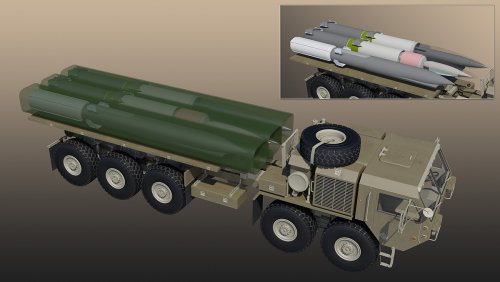
- Joined
- 9 October 2009
- Messages
- 21,947
- Reaction score
- 13,583

House panel would bar low-yield nuke deployment, Open Skies Treaty withdrawal
A proposal released June 3 would bar the deployment of a new low-yield nuclear warhead.www.defensenews.com
The bill also proposes a ban on any development of the Conventional Prompt Global Strike Weapon, or CPGS, that is unique to one platform to encourage development of a ship-based weapon. The idea is to reduce the likelihood that U.S. adversaries misinterpret the launch of a missile with conventional warheads and conclude that the missiles carry nuclear weapons.
Similar threads
-
-
New Plan for Sub Launched Conventional Ballistic Missile for PGS Mission?
- Started by bobbymike
- Replies: 0
-
Raytheon AGM-181 Long Range Stand Off Weapon (LRSO)
- Started by bobbymike
- Replies: 194
-
-

